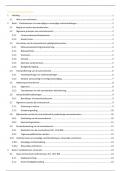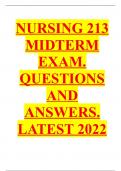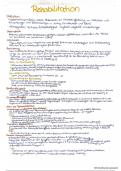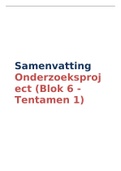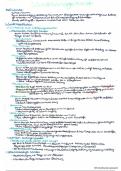Paket-deal
AQA GCSE Chemistry
AQA A-Level Changing atomic model: Atomic structure and the periodic table Chemistry Revision Questions and Answers
[ Mehr anzeigen ]AQA A-Level Changing atomic model: Atomic structure and the periodic table Chemistry Revision Questions and Answers
[ Mehr anzeigen ]Ion An atom or group of atoms that has lost or gained electrons and therefore a positive or negative charge. Polyatomic ion An ion that is made of more then one atom Metal ion an atom which has lost electrons forming a positive ion Non-metal ion an atom which has gained electrons forming nega...
Vorschau 2 aus 6 Seiten
In den EinkaufswagenIon An atom or group of atoms that has lost or gained electrons and therefore a positive or negative charge. Polyatomic ion An ion that is made of more then one atom Metal ion an atom which has lost electrons forming a positive ion Non-metal ion an atom which has gained electrons forming nega...
Transition elements are found In the middle block of the periodic tableRe Physical properties of transition elements Hard, high melthing points, strong and dense. Chemical properties of transition elements Slow/no reaction with oxygen, water and halogens Charges on transition metal ions Form ...
Vorschau 1 aus 3 Seiten
In den EinkaufswagenTransition elements are found In the middle block of the periodic tableRe Physical properties of transition elements Hard, high melthing points, strong and dense. Chemical properties of transition elements Slow/no reaction with oxygen, water and halogens Charges on transition metal ions Form ...
Mixture A combination of two or more substances that are not chemically joined. Filtration Separates insoluble solids from liquids. Crystallisation The formation of crystals by cooling a saturated solution Simple distillation Used to separate a liquid from a solution
Vorschau 2 aus 10 Seiten
In den EinkaufswagenMixture A combination of two or more substances that are not chemically joined. Filtration Separates insoluble solids from liquids. Crystallisation The formation of crystals by cooling a saturated solution Simple distillation Used to separate a liquid from a solution
Requirements for a reaction to take place Particles must collide, with sufficient energy Activation energy Minimum amount of energy required to start a chemical reaction Reaction profile diagram A graph which shows the change in energy of a chemical reaction Products The new substances formed...
Vorschau 2 aus 5 Seiten
In den EinkaufswagenRequirements for a reaction to take place Particles must collide, with sufficient energy Activation energy Minimum amount of energy required to start a chemical reaction Reaction profile diagram A graph which shows the change in energy of a chemical reaction Products The new substances formed...
H - Hydrogen He - Helium Fe - Iron N - Nitrogen Na - Sodium F - Fluorine Li - Lithium C - Carbon CO2 - carbon dioxide
Vorschau 1 aus 2 Seiten
In den EinkaufswagenH - Hydrogen He - Helium Fe - Iron N - Nitrogen Na - Sodium F - Fluorine Li - Lithium C - Carbon CO2 - carbon dioxide
Metal An element that forms positive ions pH of metal oxide Basic Non-metal Does not form positive ions pH of non-metal oxide Acidic Reduction in terms of oxygen Loss of oxygen Oxidation in terms of oxygen Gain of oxygen Oxidation in terms of electrons Loss of electrons
Vorschau 2 aus 8 Seiten
In den EinkaufswagenMetal An element that forms positive ions pH of metal oxide Basic Non-metal Does not form positive ions pH of non-metal oxide Acidic Reduction in terms of oxygen Loss of oxygen Oxidation in terms of oxygen Gain of oxygen Oxidation in terms of electrons Loss of electrons
Metals Elements which form positive ions Non-metals Elements which do not form positive ions Metals position on periodic table on the left hand side Non-metals position on periodic table
Vorschau 2 aus 8 Seiten
In den EinkaufswagenMetals Elements which form positive ions Non-metals Elements which do not form positive ions Metals position on periodic table on the left hand side Non-metals position on periodic table
Formation of metal ions Atoms lose outer electrons Metals Elements that form positive ions Formation of non-metal ions Atoms gain electrons Charge on non-metal ions negative Group 1 ions charge +1 Group 2 ions charge +2 Group 6 ions charge -2 Group 7 ions charge
Vorschau 2 aus 7 Seiten
In den EinkaufswagenFormation of metal ions Atoms lose outer electrons Metals Elements that form positive ions Formation of non-metal ions Atoms gain electrons Charge on non-metal ions negative Group 1 ions charge +1 Group 2 ions charge +2 Group 6 ions charge -2 Group 7 ions charge
Name of Group 7 elements The halogens Group 7 elements have similar chemical properties because they all have 7 outer shell electrons Diatomic molecule A molecule consisting of two atoms
Vorschau 1 aus 4 Seiten
In den EinkaufswagenName of Group 7 elements The halogens Group 7 elements have similar chemical properties because they all have 7 outer shell electrons Diatomic molecule A molecule consisting of two atoms
Atom Smallest part of an element Element A pure substance made of only one kind of atom Compound A substance made up of atoms of two or more different elements joined by chemical bonds Mixture A combination of two or more different substances that are not joined by chemical bonds
Vorschau 2 aus 5 Seiten
In den EinkaufswagenAtom Smallest part of an element Element A pure substance made of only one kind of atom Compound A substance made up of atoms of two or more different elements joined by chemical bonds Mixture A combination of two or more different substances that are not joined by chemical bonds
First shell can hold 2 electrons 2nd and 3rd shell can hold 8 electrons no of shells = Period on the periodic table Valence electrons Outer shell electrons which are involved in reactions No of valence electrons = Group number on the periodic table Hydrogen electron structure 1 Nitrogen ...
Vorschau 1 aus 3 Seiten
In den EinkaufswagenFirst shell can hold 2 electrons 2nd and 3rd shell can hold 8 electrons no of shells = Period on the periodic table Valence electrons Outer shell electrons which are involved in reactions No of valence electrons = Group number on the periodic table Hydrogen electron structure 1 Nitrogen ...
Ancient greek model of the atom Atoms are tiny solid spheres which cannot be divided. JJ Thompson Discovered the electron and developed the "plum-pudding" model of the atom plum pudding model of the atom atoms are balls of positively charge with negative electrons embedded in it
Vorschau 2 aus 7 Seiten
In den EinkaufswagenAncient greek model of the atom Atoms are tiny solid spheres which cannot be divided. JJ Thompson Discovered the electron and developed the "plum-pudding" model of the atom plum pudding model of the atom atoms are balls of positively charge with negative electrons embedded in it
Relative mass of a proton 1 Relative mass of a neutron about the same as that of a proton Relative mass of an electron 1/1840 Relative charge of a proton +1 Relative charge of a neutron 0 Relative charge of an electron -1 Neutral atoms same number of positive protons as negative electro...
Vorschau 2 aus 7 Seiten
In den EinkaufswagenRelative mass of a proton 1 Relative mass of a neutron about the same as that of a proton Relative mass of an electron 1/1840 Relative charge of a proton +1 Relative charge of a neutron 0 Relative charge of an electron -1 Neutral atoms same number of positive protons as negative electro...
What is the charge of a proton? - +1 What is the charge of a neutron? - 0 What is the charge of an electron? - -1 What is the relative mass of a proton? - 1 What is the relative mass of a neutron? - 1 What is the relative mass of an electron? - Very small How many types of atoms do elements co...
Vorschau 3 aus 29 Seiten
In den EinkaufswagenWhat is the charge of a proton? - +1 What is the charge of a neutron? - 0 What is the charge of an electron? - -1 What is the relative mass of a proton? - 1 What is the relative mass of a neutron? - 1 What is the relative mass of an electron? - Very small How many types of atoms do elements co...

Stuvia Verkäufer haben mehr als 700.000 Zusammenfassungen beurteilt. Deshalb weißt du dass du das beste Dokument kaufst.

Man bezahlt schnell und einfach mit iDeal, Kreditkarte oder Stuvia-Kredit für die Zusammenfassungen. Man braucht keine Mitgliedschaft.

Deine Mitstudenten schreiben die Zusammenfassungen. Deshalb enthalten die Zusammenfassungen immer aktuelle, zuverlässige und up-to-date Informationen. Damit kommst du schnell zum Kern der Sache.
Du erhältst eine PDF-Datei, die sofort nach dem Kauf verfügbar ist. Das gekaufte Dokument ist jederzeit, überall und unbegrenzt über dein Profil zugänglich.
Unsere Zufriedenheitsgarantie sorgt dafür, dass du immer eine Lernunterlage findest, die zu dir passt. Du füllst ein Formular aus und unser Kundendienstteam kümmert sich um den Rest.
Stuvia ist ein Marktplatz, du kaufst dieses Dokument also nicht von uns, sondern vom Verkäufer jessyqueen. Stuvia erleichtert die Zahlung an den Verkäufer.
Nein, du kaufst diese Zusammenfassung nur für $55.64. Du bist nach deinem Kauf an nichts gebunden.
4.6 Sterne auf Google & Trustpilot (+1000 reviews)
45.681 Zusammenfassungen wurden in den letzten 30 Tagen verkauft
Gegründet 2010, seit 15 Jahren die erste Adresse für Zusammenfassungen

